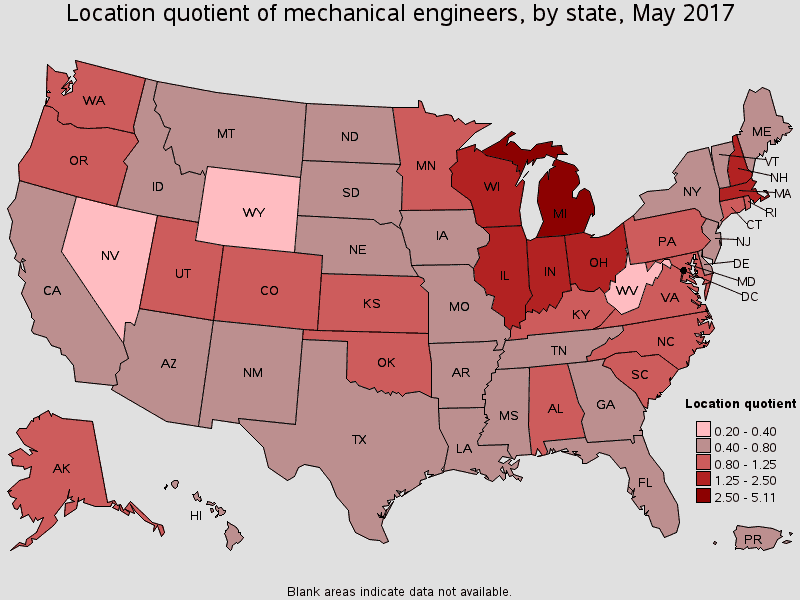Engineering Provides a Huge Benefit to Our Economy
We all know that engineers provide a valuable service and are the driving force for a large part of the global economy.
We used an innovative method to analyze employment and income data for all fifty states to determine which engineering disciplines have the greatest impact on the economy and where engineers are working. We found some surprising results.
The following article outlines the results of our research and analysis. We all know that engineering is a critical component of the US and global economy. Engineers drive a significant amount of industrial activity. Their skills and abilities improve our lives and keep us all safe. Continue reading for some less obvious benefits that professional engineers provide.
Number of Engineering Jobs
There are approximately 1.6 million engineers working in the United States, and that number is expected to grow by 4.0% next year. Approximately half of the working engineers have professional engineer (PE) licenses. Salaries for engineers are among the highest of all careers – the average engineer earns $90,060.
Total Engineers in US: 1.6 million
Location Quotient: 1.30 (130% above national average)
Job Growth (2013-2017): 4.0%
Number of PEs: 820,000
Average Earnings: $90,060
Source: US Bureau of Labor Statistics

Borrowing a Term from Economics
Economists developed a convenient way of quantifying how concentrated a particular industry, occupation, or demographic group is in a region as compared to the nation. The term, known as Location Quotient (LQ), can reveal what makes a particular region “unique” in comparison to the national average. Location quotient can help you:
- Determine which industries dominate a particular region
- Measure the “export orientation” of a profession
- Highlight a region’s most export-oriented industries
LQ for occupations are calculated by dividing the regional concentration of an occupation by the state or national concentration of that same occupation. So suppose that Civil Engineers in a region account for 0.10% of all jobs, while in the nation they account for 0.09% of all jobs. The LQ of civil engineers in the region is thus (0.1 / .09 = 1.11). This means that the region has a higher than average concentration of civil engineers.
The LQ is an analytical statistic that measures a region’s industrial specialization relative to a larger geographic unit (usually the nation). An LQ is computed as an industry’s share of a regional total for some economic statistic (earnings, GDP by metropolitan area, employment, etc.) divided by the industry’s share of the national total for the same statistic.
For example, an LQ of 1.0 in mining means that the region and the nation are equally specialized in mining; while an LQ of 1.8 means that the region has a higher concentration in mining than the nation. High-LQ occupations thus provide a workforce-oriented perspective of the region’s economic base. Such occupations are vital for the continued prosperity of the region.
What Does It All Mean
Location quotients are useful for studying the composition of jobs in an area relative to the average, or for finding areas that have high concentrations of jobs in certain occupations. For example, a location quotient of 2.0 indicates that an occupation accounts for twice the share of employment in the area than it does nationally, and a location quotient of 0.5 indicates the area’s share of employment in the occupation is half the national share.
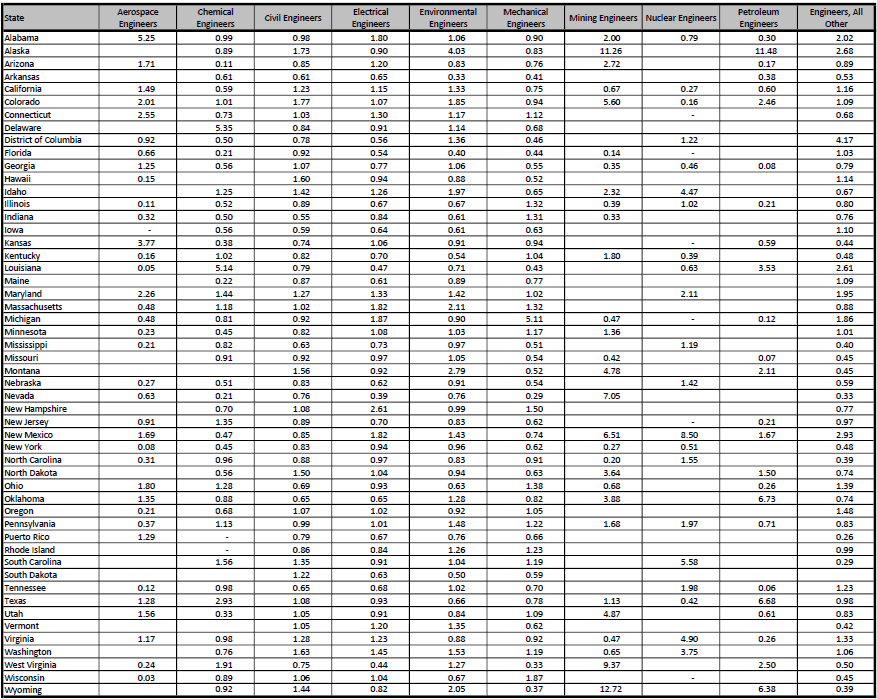
The location quotients for some engineering disciplines clustered around 1.0, indicating that their contribution is close to other engineering disciplines for those states. Some familiar and some not-so-familiar patterns emerge when looking at location quotient data. For example, the areas with the highest location quotients for mining engineers included Montana, Idaho, Nevada, and New Mexico – states with a lot of mineral resources. Florida and North Carolina have the lowest LQ for mining engineers.
What is the Most Important Engineering Discipline in Each State
Listed below are the top engineering disciplines for each state based on LQ. The significance of having a high LQ means that field of engineering makes a big contribution to the state’s economy compared to everything else.
Alabama: Aerospace Engineers
Alaska: Petroleum Engineers
Arizona: Materials Engineers
Arkansas: Electrical Engineers
California: Computer Hardware Engineers
Colorado: Mining Engineers
Connecticut: Aerospace Engineers
Delaware: Chemical Engineers
District of Columbia: Marine Engineers
Florida: Civil Engineers
Georgia: Aerospace Engineers
Hawaii: Marine Engineers
Idaho: Agricultural Engineers
Illinois: Biomedical Engineers
Indiana: Agricultural Engineers
Iowa: Agricultural Engineers
Kansas: Aerospace Engineers
Kentucky: Agricultural Engineers
Louisiana: Chemical Engineers
Maine: Environmental Engineer
Maryland: Computer Hardware Engineers
Massachusetts: Biomedical Engineers
Michigan: Mechanical Engineers
Minnesota: Biomedical Engineers
Mississippi: Marine Engineers
Missouri: Environmental Engineers
Montana: Mining Engineers
Nebraska: Nuclear Engineers
Nevada: Mining Engineers
New Hampshire: Electrical Engineers
New Jersey: Chemical Engineers
New Mexico: Nuclear Engineers
New York: Environmental Engineers
North Carolina: Nuclear Engineers
North Dakota: Mining Engineers
Ohio: Aerospace Engineers
Oklahoma: Mining Engineers
Oregon: Biomedical Engineers
Pennsylvania: Nuclear Engineers
Puerto Rico: Aerospace Engineers
Rhode Island: Marine Engineers
South Carolina: Nuclear Engineers
South Dakota: Agricultural Engineers
Tennessee: Nuclear Engineers
Texas: Petroleum Engineers
Utah: Mining Engineers
Vermont: Environmental Engineers
Virginia: Marine Engineers
Washington: Nuclear Engineers
West Virginia: Mining Engineers
Wisconsin: Mechanical Engineers
Wyoming: Mining Engineers
Engineering’s Contribution to Individual States
We prepared a series of articles that describe the importance of engineering to the economy of individual states. Check out your state in the following articles.
Alabama | Alaska | Arizona | Arkansas | California | Colorado | Connecticut | Delaware
Florida | Georgia | Hawaii | Idaho | Illinois | Indiana | Iowa | Kansas | Kentucky | Louisiana
Maine | Maryland | Massachusetts | Michigan | Minnesota | Mississippi | Missouri
Montana | Nebraska | Nevada | New Hampshire | New Jersey | New Mexico | New York
North Carolina | North Dakota | Ohio | Oklahoma | Oregon | Pennsylvania | Rhode Island
South Carolina | South Dakota | Tennessee | Texas | Utah | Vermont | Virginia | Washington
West Virginia | Wisconsin | Wyoming
How Does Each Engineering Discipline Stack Up
We compared every engineering discipline to the overall economy on a state-by-state basis. We found some surprising results. The following graph presents the results.
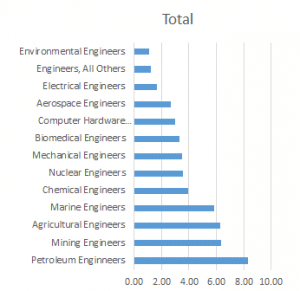
Every engineering discipline has a LQ value greater than 1. This means that all engineering disciplines contribute more to the overall economy than other sectors. This isn’t surprising. We all know that engineering is a key part of our industrial and commercial base. The LQ values simply quantify the value that engineers provide.
It is interesting to note that agricultural and marine engineers are in the Top Five. Equally surprising is the fact that aerospace and electrical engineers are in the bottom five. It’s important to note that aerospace and electrical engineers have LQs greater than 1, which indicates they contribute more to the economy than other industries. The reason for the rating has more to do with the fact tMining is a significant part of the economy in each of these states. In New Mexico and Idaho, nuclear is also a big component. Alaska also employs a lot of petroleum engineers. hat the Top Five disciplines make a tremendous contribution to GDP and the overall economy, which makes their LQs much higher.
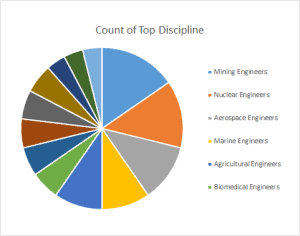
States Where Engineering Dominates the Economy
We all know that engineering makes a significant contribution to the US economy. In many states, engineering has a significant impact. The LQ rating provides a convenient way to quantify this benefit.
The top four states where engineers have an outsized impact on employment are Alaska, Wyoming, New Mexico, and Idaho. Mining is a significant part of the economy in each of these states. In New Mexico and Idaho, nuclear is also a big component. Alaska also employs a lot of petroleum engineers.
States Where Engineering Has Less Impact
Surprisingly, several states derive less economic benefit from engineering relative to other economic activity. In other words, engineering is not an important component of the state’s economy.
The states with the lowest average LQ for all engineering disciplines are:
Nebraska: (LQ = 0.66)
Missouri: (LQ = 0.62)
New York: (LQ = 0.55)
Florida: (LQ = 0.50)
Arkansas: (LQ = 0.48)
If we take a closer look at these states, we find that other segments of the economy are very large, which makes engineering’s contributions seem smaller. Florida, for example, has a very big tourist industry. New York has a substantial financial industry. In these states, engineering is important and contribute to the economy. However, the impact is not as large because their economies are dominated by other industries.
Statistics for Mechanical Engineers
Salary Information for Mechanical Engineers
Mechanical engineers generally earn a good living. The median salary for mechanical engineers is about $98,000 annually. The map below shows the annual salary for mechanical engineers for each state.
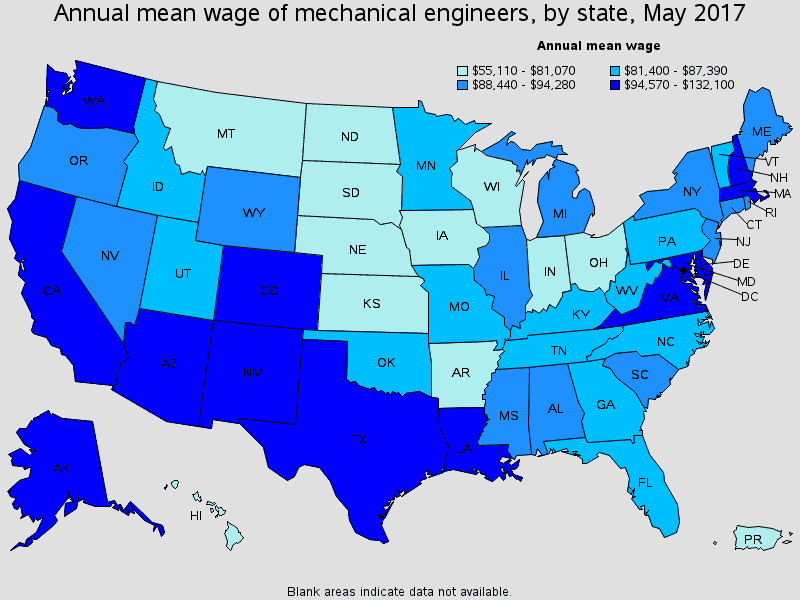
Employment for Mechanical Engineers
Let’s take a look at employment statistics for mechanical engineers. The graphic below shows the number of mechanical engineers employed in each state. You can see there are a lot of ME’s working in Washington, California, Texas, Florida, Virginia, North Carolina, and the mid-Atlantic states.
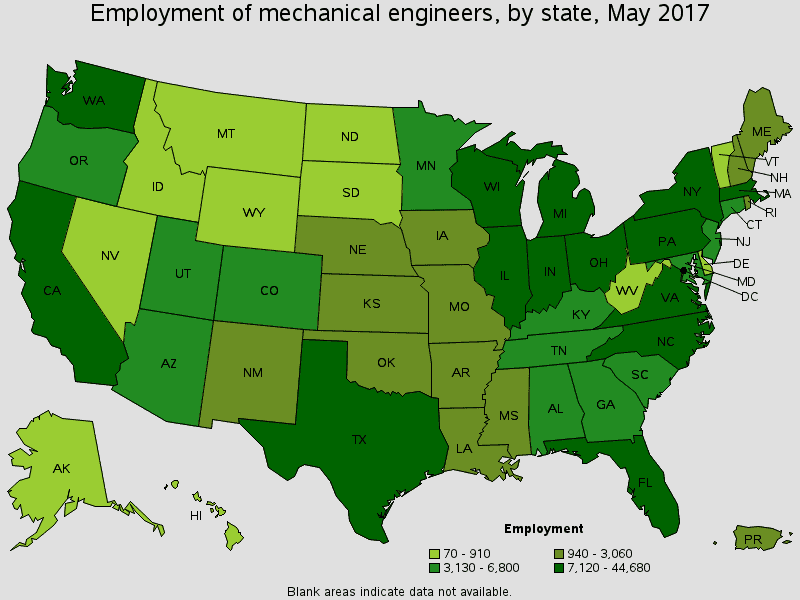
Location Quotient for Mechanical Engineers
When we look at these employment numbers through the lens of location quotient, we see a different pattern. California, Texas, Florida have location quotients below the national average despite the fact that these states employ a lot of mechanical engineers. Michigan has the highest location quotient of all 50 states. This indicates that mechanical engineers have an outsized influence on the state’s economy.
